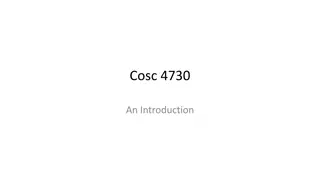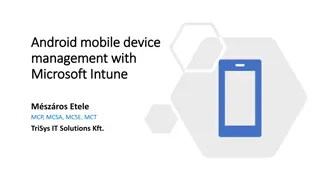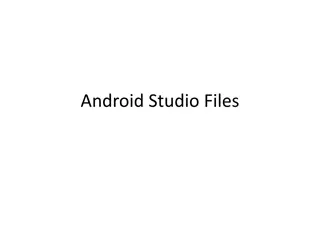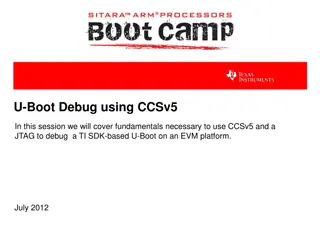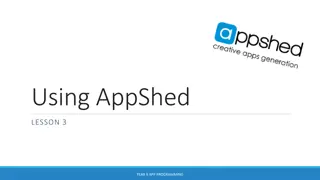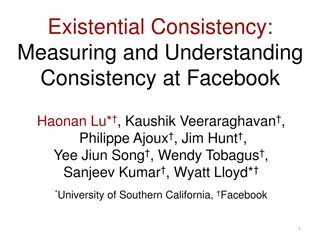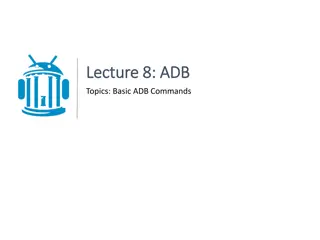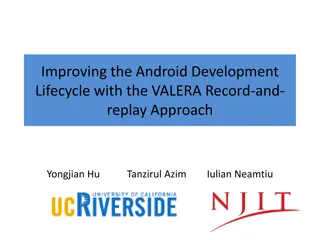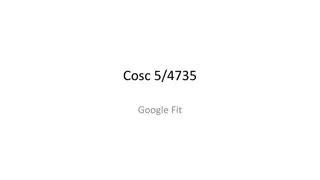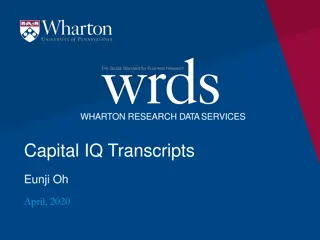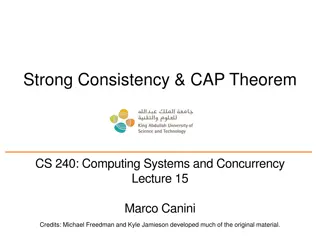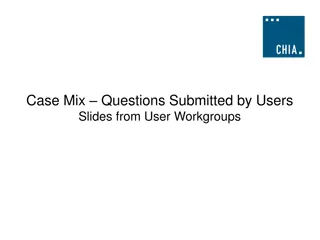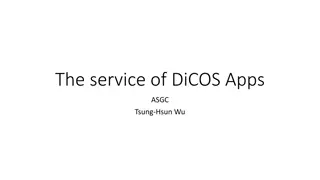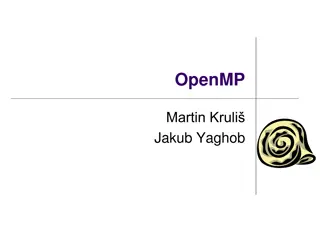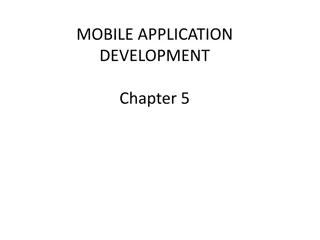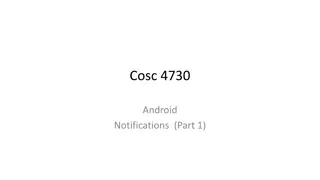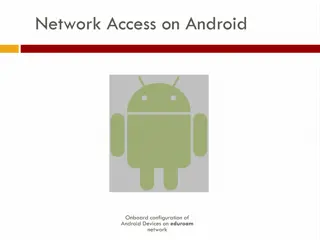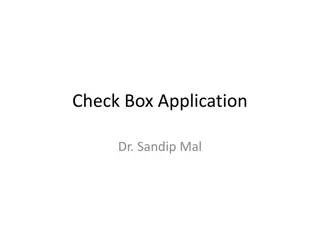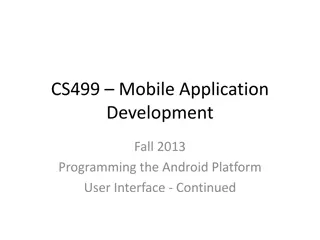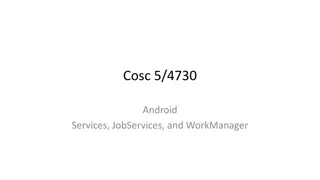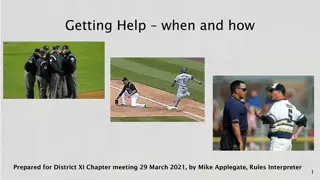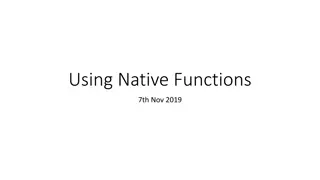Analyzing Declared SDK Versions' Consistency with API Calls in Android Apps
Understanding the importance of Declared SDK (DSDK) versions in Android apps and their impact on API calls. Exploring the potential side effects of incorrect SDK version declarations and the need for developers to adhere to proper SDK versioning practices for compatibility and security. Delve into examples showcasing how inappropriate SDK versions can lead to vulnerabilities and failures in app functionality.
Download Presentation

Please find below an Image/Link to download the presentation.
The content on the website is provided AS IS for your information and personal use only. It may not be sold, licensed, or shared on other websites without obtaining consent from the author. Download presentation by click this link. If you encounter any issues during the download, it is possible that the publisher has removed the file from their server.
E N D
Presentation Transcript
Measuring the Declared SDK Versions and Their Consistency with API Calls in Android Apps Daoyuan Wu, Ximing Liu*, Jiayun Xu*, David Lo, and Debin Gao School of Information Systems Singapore Management University 1 *: co-second author.
The fast-evolving Android has multiple platform versions active in the market! Declare the supported platform SDK versions An Android App a modern software mechanism 2 Image source: http://olx.uz/obyavlenie
The Declared SDK (DSDK) Versions in Android Apps It is different from the traditional compiling SDK (CSDK). DSDK records the supported platform SDK versions, which are for the runtime Android system to check apps compatibility. The targetSdkVersion integer designates the platform SDK The maxSdkVersion integer specifies the maximum The minSdkVersion integer specifies the minimum platform SDK version required for the app to run. version that the app targets at. backward-compatible platform SDK version on which the app can run. 3
Does this software mechanism work as Google thought? (Is it a silver bullet?) Could developers declare the supported platform SDK versions correctly? 4
First, we show that in theory, this software mechanism do have side effects. 5
Inappropriate DSDK Versions and Two Side Effects Added APIs Removed APIs A patched API minSDK targetSDK maxSDK From app manifest: minLevel maxLevel From appAPI calls: Crash Less secure Crash Android platforms: 6
Examples of the Side Effect II: Making Apps Fail to Get Secure Content provider component is by default exported prior to Android 4.2. Caused a number of vulnerable apps in year 2011-12. Android changed this policy since 4.2 (API level 17). However, developers need to set targetSdkVersion >= 17. Otherwise, Android still uses the old policy, even on higher versions of platforms. addJavascriptInterfaceremote code execution via Java reflection Android 4.2 disables such Java reflection based attacks. Similarly, developers need to upgrade targetSdkVersion. 7
How about the reality? Do real-world apps suffer from these two side effects? 8
The Objectives of Our Study Android App Manifest <uses-sdk> Dex bytecodes Consistency 2 1 The current practice of DSDK versions in real apps 9
Google Play Websites Crawled Android Apps Android API Documents Methodology Google Play Analysis Document Analysis Three-dimensional analysis: Google Play level API-SDK mapping Filtered multiple- apk apps Single-apk Apps Manifest Bytecode Android Document level aapt dexdump Min/Target/Max DSDK versions API calls and their SDK versions Android App level Comparison App Analysis Characteristic Results Consistency Results 10
Android Document Analysis All added APIs are given by api-versions.xml The removed APIs can be got from the api_diff directory included in the Android Doc. 11
The Result of Document Analysis A total of 30,083 APIs are added 794 deprecated APIs 190 removed APIs among all the 23 versions However, we found that such document-based analysis initially proposed by an ICSM 13 work [1] has problems: The deprecated and removed lists are not accurate. [1] T. McDonnell, B. Ray, and M. Kim, An Empirical Study of API Stability and Adoption in the Android Ecosystem, In Proc. IEEE ICSM, 2013. 12
So We Focus on Added APIs Distribution of the versions of added APIs Distribution of APIs added in the versions >1 APIs added in version 1 and APIs added later 13
The dataset of our study All apps were crawled in July 2015. Our analysis was finished in April 2016, when Android 6.0 was the latest version. 14
Android App Analysis API-SDK mapping We wrote python scripts to drive aapt (Android Asset Packaging Tool) and dexdump tools. These two are more robust than apktool and dex2jar. All succeed for aapt; Only two failed for dexdump. 2/23,125 Single-apk Apps Manifest Bytecode aapt dexdump Min/Target/Max DSDK versions API calls and their SDK versions Comparison App Analysis Consistency Results In contrast, the failure rate of apktool is 6/1,000. 15
Retrieving Declared SDK Versions Observed and handled two kinds of special cases: Some apps define minSdkVersion multiple times, for which we only extract the first value. We apply the by-default rules for the non-defined minSdkVersion and targetSdkVersion. 16
Extracting API Calls Whether clsName covers pkgName (1) Also locate the class line (for excluding the library code) (1) Locate the invoke lines (2) Extract the API portion (3) Remove the redundancy 17
Computing the Levels of API Calls minLevel maxLevel From appAPI calls: API added in v1 API added in v5 API never removed API removed in v17 API added in v1 API added in v9 API never removed API removed in v19 minLevel = 9 maxLevel = 17 18
Evaluation Research Questions RQ1: What are the characteristics of the DSDK versions in real-world apps? Key Findings Out of 23,125 apps we analyzed: Around 17% apps do not claim the targeted DSDK versions or declare them inappropriately. Around 1.8K apps under-set the minimum DSDK versions, causing them to crash when running on lower platforms. Over 400 apps under-claim the targeted DSDK versions, making them potentially exploitable by remote code execution. RQ2: Could we identify the inconsistency between DSDK versions and API calls in real apps? In particular, could we discover crash bugs and potential security vulnerabilities? 19
Not all apps define the minSdkVersion and targetSdkVersion attributes, and 16.5% apps do not claim the targetSdkVersion attributes. 20
The minimal platform versions most apps support are Android 2.3 and 2.2, whereas the most targeted platform versions are Android 4.4 and 5.0. (for our dataset in July 2015) Android 4.4 Android 2.3 Android 5.0 Android 2.2 21
Around 1.8K apps under-set the minSdkVersion value, causing them to crash on lower platforms. 2 1 minLevel > minSdkVersion apiOverNum >=5: 1 60% = 40% = 1,750 1 apiOverNum >=10: 1 84% = 16% = 692 2 5 10 22
Around 400 apps fail to update their targetSdkVersion values, making them potentially exploitable by remote code execution. 909 apps call the addJavascriptInterface() API Based on all API calls for app codes. 413 apps are potentially vulnerable, Because their targetSdkVersion < 17 (Android 4.2) Interestingly, 238 of them do not define the targetSdkVersion attribute (i.e., it is null). 23
Conclusions and Takeaways We are the first to systematically measure the declared SDK versions (a modern software mechanism) and their consistency with API calls in Android apps. Two key findings (out of 23,125 apps we analyzed): Around 1.8K apps under-set the minimum DSDK versions, causing them to crash on lower platforms; Over 400 apps under-claim the targeted DSDK versions, making them potentially exploitable on all platforms. Contact: Daoyuan Wu (dywu.2015@smu.edu.sg) 24


